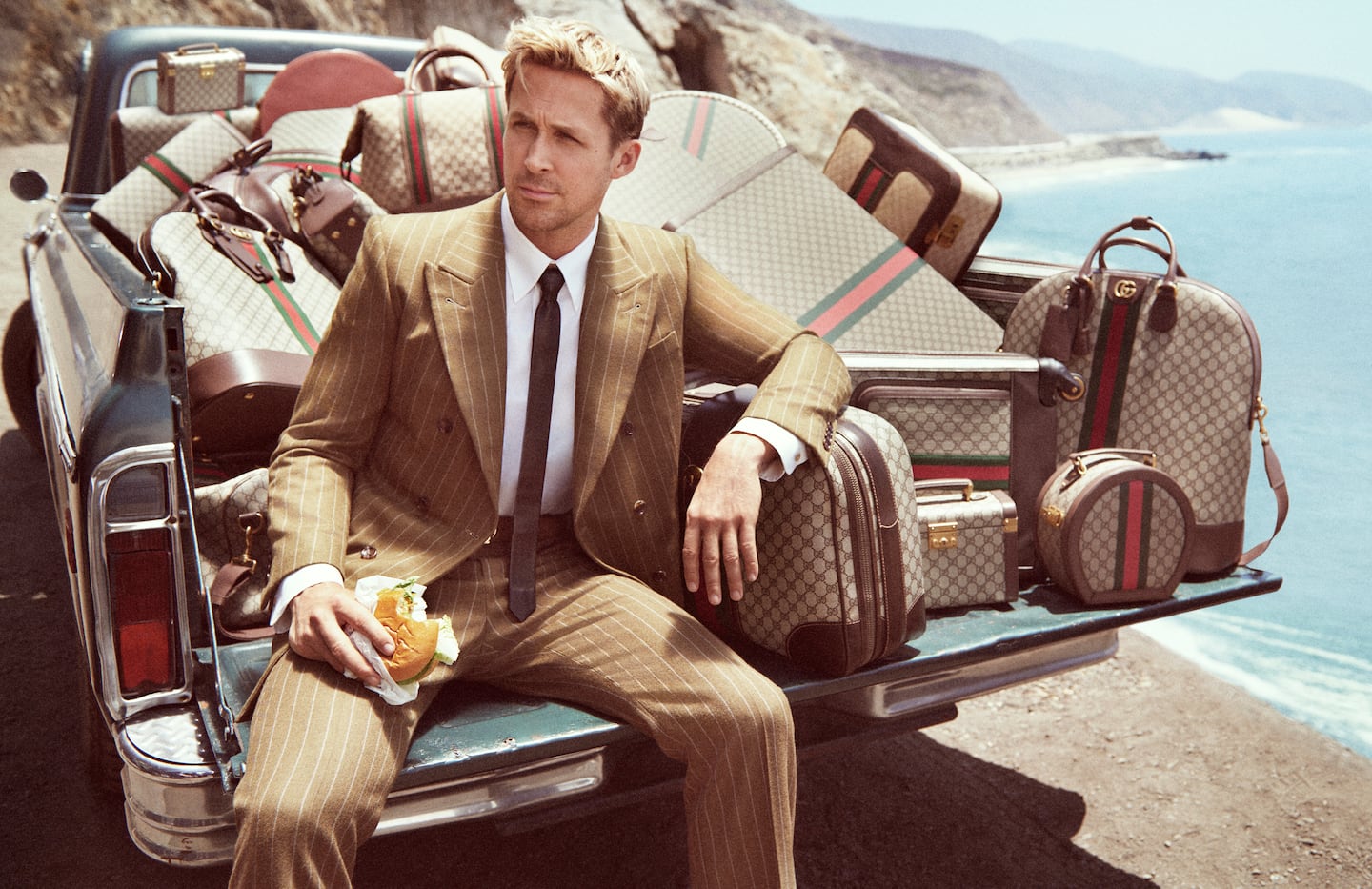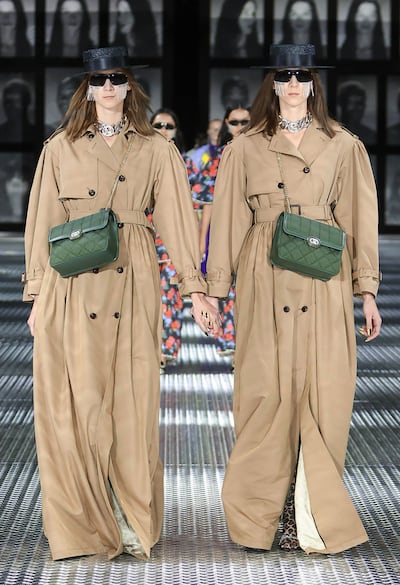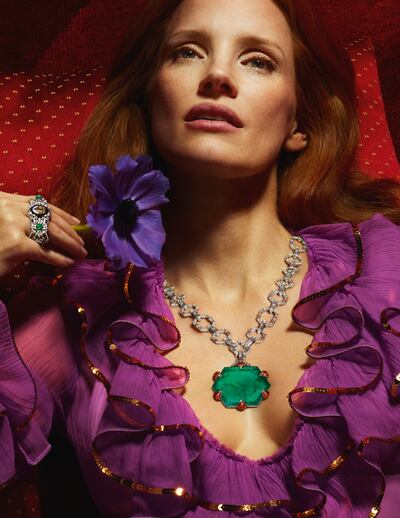
The Business of Fashion
Agenda-setting intelligence, analysis and advice for the global fashion community.

Agenda-setting intelligence, analysis and advice for the global fashion community.

Does Gucci’s new luggage campaign signal a return to more classic luxury marketing after years of leaning into a fashion-driven approach?
Whereas Gucci’s advertising has often celebrated quirkiness, irony and maximalist kitsch — piling oversized sunglasses, bright headscarves and rhinestone-studded track jackets on models — the big-budget travel shoot released in October takes a different tack. A-list ambassador Ryan Gosling poses amid piles of the brand’s most timeless travel gear including trunks, duffles and toiletry cases in monogrammed canvas; dressed in similarly timeless menswear like loafers, pinstripe suits, skinny ties and beachy Hawaiian shirts.
The twisted, high-low stamp of Gucci’s creative director Alessandro Michele is still visible: Gosling is photographed eating a fast-food burger and reading trashy tabloids amid his luxe affairs, and in certain images dons a campy Western-wear ensemble. But the campaign’s overall thrust is clear: a conventionally masculine Hollywood star styled for broad appeal.
The travel campaign comes as parent company Kering works to reassure investors that Gucci — its most profitable brand and, until 2020, the industry’s fastest-growing company — is making progress on a broader strategic push to appear more luxurious and timeless.
ADVERTISEMENT
For nearly three years, Gucci’s growth has lagged top rivals like Hermès and Louis Vuitton owner LVMH, whose more classic branding appealed to customers who increasingly sought out blue-chip status symbols and products that seemed unlikely to go out of style.
Before the pandemic, the fashion-driven reboot of Gucci under designer Michele and CEO Marco Bizzarri set the style agenda with its eye-catching maximalism, cheeky play with logos and a mix of sporty and elevated pieces, delivering the most successful turnaround in the history of the modern luxury sector. Between 2015 and 2019, sales more than doubled and profits roughly quadrupled. But revenue slumped by 23 percent in 2020 as coronavirus hammered tourist shopping, on which Gucci depended more than rivals to drive growth.
After scaling back its exposure to wholesale and other off-price channels in a bid to strengthen its business last year, the brand now hopes to accelerate growth by leaning into its current momentum in North America (opening stores in markets like Nashville and Montréal), revamping its management structure in China, growing timeless, high-end categories like luggage and jewellery and supporting its menswear with stand-alone fashion shows.
Central to Gucci’s plan is a major product and marketing transition aimed at leveraging its 100-year heritage and asking consumers to pay more for its most iconic pieces.
“There’s been a view in the market that [Gucci] leaned a bit too far into fashion and needed to rebalance,” said Aurélie Husson-Dumoutier, analyst at HSBC. “The most powerful luxury brands are able to grow at the same time heritage and fashion.”

Upmarket Evolution
This year, Alessandro Michele has shown he can continue to wow devotees with runway shows that remain true to his off-kilter, maximalist vision, while also introducing more classic, sexy and elevated items: A June show in Puglia was textbook Michele — featuring a magpie-style mashup of historical references — but also debuted ultra-classic monogram-and-leather pocketbooks and top-end python styles. A September outing during Milan Fashion Week, featuring 68 identical twins walking hand-in-hand, generated $18.8 million in online buzz, according to consultancy Launchmetrics, while also showcasing newly understated trenchcoats and quilted crossbody bags.
“It’s sophisticated, opulent and timely,” said Tiffany Hsu, Mytheresa’s vice president of womenswear buying, of Gucci’s current offer. “For a while people’s image of Gucci was very sporty, but the more elevated part of the collection does well for us — they’ve extended the cocktail assortment with high and really-high priced gowns, and then there’s the suiting and tweed jackets, silk shirts for everyday, which are serving a lot of people.”
ADVERTISEMENT
Data shows that compared to a year ago, Gucci has both expanded its selection — increasing the number of SKUs by 20 percent to 5,700 items — as well as reinforcing its focus on high luxury price points. The number of items priced above £2,500 ($2,830) has doubled year-on-year, according to RBC Capital Markets analyst Piral Dadhania. The number of bags priced at under £1,500 pounds dropped by 30 percent, marking a shift away from Gucci’s pre-pandemic assortment of bestsellers, which more heavily featured items like the Soho Disco crossbody (then priced at $1,190).
Other initiatives aimed at elevating the Gucci brand include pushes into high jewellery and watches. Earlier this year, the brand released its third haute joaillerie collection (with a campaign starring Jessica Chastain) and its second-ever high watchmaking collection (fronted by Idris Elba). The market for those couture-level brand extensions is tiny; these categories are usually more about driving image than sales volumes. But in addition to elevating brand perception, these top-end moves could reinforce Gucci’s credibility in more saleable segments like fine jewellery, fashion jewellery or fine and fashion watches.
Growth Gap
Still, Gucci’s up-market evolution has yet to lift the brand’s growth in line with top peers, causing Kering’s share price to tumble following recent earnings reports. The brand’s comparable sales rose 9 percent in the third quarter, compared to a 22 percent jump for LVMH’s fashion division and a 24 percent growth at Hermès.
At an investor day in June, the group presented a suite of changes aimed at accelerating the business. A new merchandising director, Maria Cristina Lomanto (a veteran executive of Prada’s Miu Miu line and the former CEO of Roger Vivier shoes), has been brought on to help revamp commercial products, filling a gap left by the brand’s former merchandising chief Jacopo Venturini, who left to become CEO of Valentino in 2019.
One of Alessandro Michele’s longtime deputies has also been promoted to the role of studio director to oversee an expanded team as the company prepares for a “full return to the fashion calendar.” After experimenting with combining collections into two big co-ed shows per year, the brand hopes to boost innovation, stay in the fashion conversation and better highlight its menswear offer by going back to six collections and five shows per year (two women’s ready-to-wear outings, two standalone men’s shows and a co-ed cruise).
Gucci also named a new president for the key Chinese market — former Tiffany & Co. executive Laurent Cathala — and reshuffled its marketing and communications structure. Susan Chokachi, formerly CEO of Gucci Americas, has become executive vice president, chief brand and client officer, while existing marketing boss Robert Triefus will transition to a new role as CEO of Gucci Vault and metaverse ventures, while continuing to supervise marketing as the executive vice president for corporate and brand strategy. Company sources say Benjamin Cercio, a longtime Louis Vuitton executive known for his deft touch in celebrity relations and red-carpet dressing, is also set to join the company in a top communications role.
Kering has said its strategy aims to transition Gucci from a period of fashion-driven “reinvention” to a new era of “sustainable elevation.” The company appears to be looking for a way to simultaneously support Michele’s maximalist vision — which continues to drive nearly 10 billion euros in annual sales — while crafting a more timeless image to reinforce Gucci’s broad-based appeal with moves like the recent Gosling travel campaign.
ADVERTISEMENT

A Changing Playbook
While Gucci is making progress on implementing its strategy, the market remains sceptical: Kering’s shares have fallen 29 percent year-to-date, compared to an industry average of 20 percent according to Savigny Partners’ index of listed luxury firms.
“The initiatives they’re putting in place, they can help with sales densities. They will have some impact, but it’s more on a technical front, not the brand direction,” UBS analyst Zuzanna Pusz said. “There’s a feeling among market participants that the brand is a little bit fatigued, that they need a little bit of a fresh look.”
Reigniting growth without fully recasting a brand’s creative structure is a new challenge for Kering: At stablemates Bottega Veneta and Balenciaga in addition to Gucci, the conglomerate has developed a winning playbook for overhauling the images of its brands, betting on designers with bold creative visions and then extending them to every part of the company, from runways to stores to ad campaigns. Designers then hammer the brands’ new message with relatively consistent collections, rather than chasing new horizons from outing to outing. Executives refer to the approach internally as “freedom within a framework.”
But at Gucci’s current scale, the playbook itself may be what needs refreshing. The label’s top-to-bottom, ultra-consistent approach to branding and design has been a key driver of its pre-pandemic success, helping to amplify its message and more than double sales. In its next chapter, the brand might take a hint from larger rival Louis Vuitton. There, womenswear director Nicolas Ghesquière and late menswear star Virgil Abloh have enjoyed relatively free reign to express their runway visions, while the company’s more stable, neutral branding and store concept provide a shared canvas for their creations, as well as providing a suitable platform for less fashion-driven categories like jewellery and watches.
At Gucci, a cleaner, more permanent brand platform might help renew excitement around Michele’s designs. It could also make room for additional creative voices alongside Michele: Other brands of a similar scale like Hermès, Vuitton and Dior employ multiple creative directors for categories like menswear, womenswear, jewellery and homeware, with the divergent voices helping to broaden their audience and transcend the volatility of fashion cycles.
“You can accept the fact that Gucci has had a more fashion-driven DNA. The question is more about how you respond to it,” UBS’ Pusz said. “There are different ways to manage that perceived volatility.”
First-quarter sales missed estimates at Gucci. The Italian mega-brand’s uneven pandemic rebound has some investors worried after years of dizzying growth.
‘Mission accomplished’ at the French group as flagship label Gucci’s sales climbed back above 2019 levels, a key milestone in its recovery from the pandemic.
After years of blockbuster growth, Gucci is struggling to bounce back from the pandemic. Getting back on track will require the brand to appeal to multiple tribes of consumers.

Robert Williams is Luxury Editor at the Business of Fashion. He is based in Paris and drives BoF’s coverage of the dynamic luxury fashion sector.
Brands from Valentino to Prada and start-ups like Pulco Studios are vying to cash in on the racket sport’s aspirational aesthetic and affluent fanbase.
The fashion giant has been working with advisers to study possibilities for the Marc Jacobs brand after being approached by suitors.
A runway show at corporate headquarters underscored how the brand’s nearly decade-long quest to elevate its image — and prices — is finally paying off.
Mining company Anglo American is considering offloading its storied diamond unit. It won’t be an easy sell.